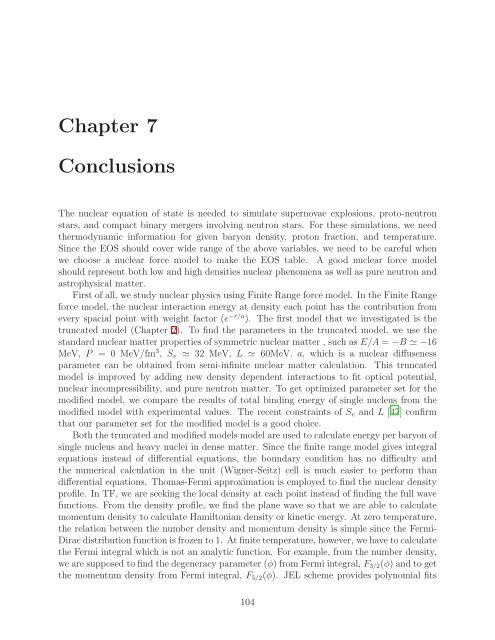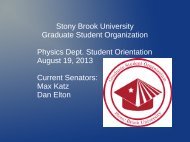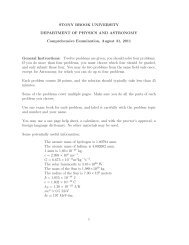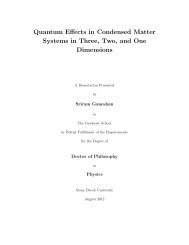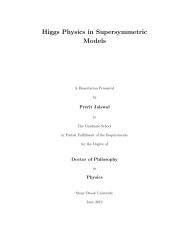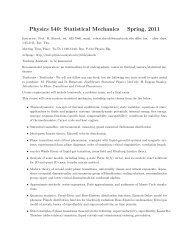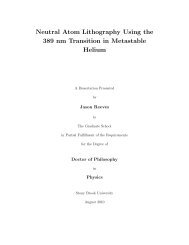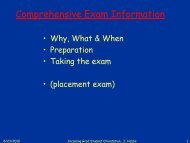Chapter 7ConclusionsThe nuclear equation <strong>of</strong> state is needed to simulate supernovae explosions, proto-neutronstars, <strong>and</strong> compact binary mergers involving neutron stars. For these simulations, we needthermodynamic in<strong>for</strong>mation <strong>for</strong> given baryon density, proton fraction, <strong>and</strong> temperature.Since the EOS should cover wide range <strong>of</strong> the above variables, we need to be careful whenwe choose a nuclear <strong>for</strong>ce model to make the EOS table. A good nuclear <strong>for</strong>ce modelshould represent both low <strong>and</strong> high densities nuclear phenomena as well as pure neutron <strong>and</strong>astrophysical matter.First <strong>of</strong> all, we study nuclear physics using Finite Range <strong>for</strong>ce model. In the Finite Range<strong>for</strong>ce model, the nuclear interaction energy at density each point has the contribution fromevery spacial point with weight factor (e −r/a ). The first model that we investigated is thetruncated model (Chapter 2). To find the parameters in the truncated model, we use thest<strong>and</strong>ard nuclear matter properties <strong>of</strong> symmetric nuclear matter , such as E/A = −B ≃ −16MeV, P = 0 MeV/fm 3 , S v ≃ 32 MeV, L ≃ 60MeV. a, which is a nuclear diffusenessparameter can be obtained from semi-infinite nuclear matter calculation. This truncatedmodel is improved by adding new density dependent interactions to fit optical potential,nuclear incompressibility, <strong>and</strong> pure neutron matter. To get optimized parameter set <strong>for</strong> themodified model, we compare the results <strong>of</strong> total binding energy <strong>of</strong> single nucleus from themodified model with experimental values. The recent constraints <strong>of</strong> S v <strong>and</strong> L [47] confirmthat our parameter set <strong>for</strong> the modified model is a good choice.Boththe truncated <strong>and</strong>modified models model areused tocalculate energy per baryon<strong>of</strong>single nucleus <strong>and</strong> heavy nuclei in dense matter. Since the finite range model gives integralequations instead <strong>of</strong> differential equations, the boundary condition has no difficulty <strong>and</strong>the numerical calculation in the unit (Wigner-Seitz) cell is much easier to per<strong>for</strong>m th<strong>and</strong>ifferential equations. Thomas-Fermi approximation is employed to find the nuclear densitypr<strong>of</strong>ile. In TF, we are seeking the local density at each point instead <strong>of</strong> finding the full wavefunctions. From the density pr<strong>of</strong>ile, we find the plane wave so that we are able to calculatemomentum density to calculate Hamiltonian density or kinetic energy. At zero temperature,the relation between the number density <strong>and</strong> momentum density is simple since the Fermi-Diracdistributionfunctionisfrozento1. Atfinitetemperature, however, wehavetocalculatethe Fermi integral which is not an analytic function. For example, from the number density,we aresupposed t<strong>of</strong>ind thedegeneracy parameter (φ)fromFermi integral, F 3/2 (φ)<strong>and</strong>to getthe momentum density from Fermi integral, F 5/2 (φ). JEL scheme provides polynomial fits104
<strong>for</strong> Fermi integral. This fitting function has remarkably high accuracies to calculate Fermiintegral. We employ JEL scheme to calculate nuclear <strong>for</strong>ce at finite temperature.To find the density pr<strong>of</strong>ile <strong>of</strong> nuclei, we use Euler-Lagrange equations to minimize totalbinding energy, <strong>and</strong> it gives that µ n,i <strong>and</strong> µ p,i are constant in the cell if we set the densityat each grid point as unknown. The multi-dimensional Newton-Raphson method is usedto solve the equations. If the initial guess is good enough, the number <strong>of</strong> iterations to getsolutions is only two or three so the code is fast enough to calculate binding energy <strong>of</strong> allnuclei present on earth.The bulk equilibrium calculation is an example <strong>of</strong> using JEL scheme. Bulk (dense-dilute)matter equilibrium is the simplified case <strong>of</strong> heavy nuclei in dense matter. That is, if bulkequilibrium is possible, that suggests there might be a phase <strong>of</strong> heavy nuclei in dense matter.If bulk equilibrium does not exist, there would be uni<strong>for</strong>m nuclear matter phase <strong>for</strong> givendensity, proton fraction, <strong>and</strong> temperature. The conditions <strong>for</strong> bulk equilibrium are made byminimizing the total free energy density, which are P I = P II , µ nI = µ nII , <strong>and</strong> µ pI = µ pII .I(II) represent dense (dilute) phase. From phase equilibrium calculations, we can get thecriticaltemperatureinwhichbothphaseshavethesamedensity <strong>and</strong>protonfraction. Beyondthe critical temperature, phase equilibrium does not exist any more. Semi-infinite nuclearmatter density pr<strong>of</strong>ile is obtained from the finite range <strong>for</strong>ce models. Since the curvatureeffect <strong>of</strong> finite nuclei is small, the semi-infinite nuclear matter calculation is used to find thesurfacetension<strong>for</strong>nuclei. Withthecriticaltemperaturefromphaseequilibrium, semi-infinitecalculation gives analytic fitting function <strong>for</strong> surface tension <strong>for</strong>mula (ω = ω(x,T)).The importance <strong>of</strong> choosing <strong>of</strong> nuclear <strong>for</strong>ce model to make EOS table can also be seenwhen we study neutron star crust. The nuclear potentials have a lot <strong>of</strong> different <strong>for</strong>m. Thesedifference does not effect the pressure, energy density, <strong>and</strong> atomic number in neutron starcrust. If we extend the potentials, however, to high density, the difference in the mass-radiusrelation <strong>of</strong> neutron stars is apparent.Using the finite-range model with liquid droplet approach, we build EOS table <strong>for</strong> astrophysicalsimulations. Thomas-Fermi <strong>and</strong> Hartree (Fock) approximation gives only numericalquantities <strong>of</strong> thermodynamic quantities. On the other h<strong>and</strong>, liquid droplet approach givesanalytic thermodynamic quantities, that means thermodynamic consistency. Compared toLS EOS <strong>and</strong> LPRL [17], our LDM approach contains neutron skins <strong>and</strong> surface diffusenessto improve the liquid droplet <strong>for</strong>malism. The LDM approach is fast to build the full EOStable so that we can manipulate different nuclear <strong>for</strong>ce model without difficulty <strong>and</strong> we canmake an EOS table with a large number <strong>of</strong> grid points. The atomic number at the lowerdensity region (≃ 0.01/fm 3 ) remains around 30 <strong>and</strong> has experienced abrupt changes betweenthe phase transition regions (0.5ρ 0 ). This is a general feature in both the non-relativisticmean field model <strong>and</strong> relativistic mean field model. In the phase transition region, theatomic number from RMF models is an order <strong>of</strong> magnitude greater than the one from thenon-relativistic potential models. Between SLy4 <strong>and</strong> finite range <strong>for</strong>ce model, the phasetransition to uni<strong>for</strong>m matter happens later in SLy4. Since the truncated model has thehigher critical temperature than SLy4 <strong>and</strong> the modified model, nuclei can exist in highertemperature in the truncated model.It is necessary to compare the EOS tables using the same nuclear <strong>for</strong>ce model but withdifferent numerical techniques (LDM, TF, HF) to see how similar the each EOS table wouldbe. This work will be begun in the near future.105
- Page 1 and 2:
Theory of nuclear matter of neutron
- Page 3 and 4:
Abstract of the DissertationTheory
- Page 5 and 6:
To Jaenyeong, Jonghyun, and Jongbum
- Page 7 and 8:
3.3 Optimized Parameter Set . . . .
- Page 9 and 10:
List of Figures1.1 Mass and radius
- Page 11 and 12:
SymbolsNuclear Physics SymbolE ener
- Page 13 and 14:
ω δt 90−10QtT cTaylor expansion
- Page 15 and 16:
List of Tables1.1 Range of Tables .
- Page 17 and 18:
Chapter 1IntroductionStars give us
- Page 19 and 20:
Since the mass of neutron star is d
- Page 21 and 22:
shown in Fig. 1.2, LS220 is the onl
- Page 23 and 24:
density:p = ρ2ρ o[ K9µ n = −B
- Page 25 and 26:
nuclear energy density functional i
- Page 27 and 28:
2.3.2 Thermodynamic QuantitiesThe t
- Page 29 and 30:
point r and with momentum p isU n (
- Page 31 and 32:
Thus, in the case of zero temperatu
- Page 33 and 34:
For standard nuclear matter, u = 1
- Page 35 and 36:
a α L α U β L β U σ0.5882 1.11
- Page 37 and 38:
Figure 2.2: Bulk equilibrium of T =
- Page 39 and 40:
Figure 2.4: Coexistence curves for
- Page 41 and 42:
proton fraction x are irrelevant fo
- Page 43 and 44:
potential model analogue for the Ha
- Page 45 and 46:
with the convention that z II is th
- Page 47 and 48:
Figure 2.10: The surface tension of
- Page 49 and 50:
Figure 2.12: Contour plots of surfa
- Page 51 and 52:
2.6.2 Dense Matter and the Wigner-S
- Page 53 and 54:
Figure 2.15: Proton number per unit
- Page 55 and 56:
Chapter 3Modified model† The trun
- Page 57 and 58:
We choose the value ǫ = 1/3. One m
- Page 59 and 60:
where∆V t = T oρ o[( ρρ o) ǫ[
- Page 61 and 62:
Q 1 to a small number also results
- Page 63 and 64:
where p = (S v ,L) and M ij = 1 ∂
- Page 65 and 66:
3.4 Nuclear Surface TensionCompared
- Page 67 and 68:
1.41.2FRTF II ω 0 , T=0 MeVFRTF II
- Page 69 and 70: For the finite-range term, we use a
- Page 71 and 72: Landau’s quasi-particle formula g
- Page 73 and 74: The symmetry energy in nuclear matt
- Page 75 and 76: Figure 4.2: The left figure shows t
- Page 77 and 78: Figure 4.4: This figure shows the b
- Page 79 and 80: Figure 4.5: In a neutron star, heav
- Page 81 and 82: The energy exchange from the gradie
- Page 83 and 84: Figure 4.8: The left panel shows th
- Page 85 and 86: 4.5 Astrophysical application4.5.1
- Page 87 and 88: 0.550.5GaussianFRTF IIFRTF I0.450.4
- Page 89 and 90: neutron matter respectively. Those
- Page 91 and 92: Table 5.3: Nuclear properties of si
- Page 93 and 94: which aref Rc = a 0 +a 1 x+a 2 x 2
- Page 95 and 96: parametrized[ht]504540EDF, Z nucFit
- Page 97 and 98: Chapter 6Nuclear Equation of State
- Page 99 and 100: Coulomb, and, symmetry part [24], i
- Page 101 and 102: We can eliminate N s , leading to t
- Page 103 and 104: pressure from pure neutron matter,
- Page 105 and 106: 2.52GSRsSGISIVSkaSkI1SkI2SkI3SkI5St
- Page 107 and 108: HNsn, p, α,eFigure 6.7: In the Wig
- Page 109 and 110: Table 6.1: Surface tension analytic
- Page 111 and 112: free energy density for the alpha p
- Page 113 and 114: Here s ′ = ∂s(u)/∂u.The minim
- Page 115 and 116: 6.5.2 Determination of Coulomb surf
- Page 117 and 118: gives analytic derivatives of therm
- Page 119: 200180160Atomic number, Y p =0.45,
- Page 123 and 124: A.1 Taylor expansion integrationThe
- Page 125 and 126: thenwhere0u − i+1 = fu− i +J
- Page 127 and 128: We separate the two integrals as in
- Page 129 and 130: Each w i can be obtained[ae −∆/
- Page 131 and 132: By expanding e r 0/a −e −r 0/a
- Page 133 and 134: M 3 2a 0.433 1p 0 (e 2 /a) √ π/3
- Page 135 and 136: of find exact polynomial expression
- Page 137 and 138: Appendix CPhase coexistenceBulk equ
- Page 139 and 140: To summarize, we need to solve 5 eq
- Page 141 and 142: D.1 Non-uniform electron density ap
- Page 143 and 144: Appendix ENuclear Quantities in Non
- Page 145 and 146: Table E.1: Non-relativistic Skyrme
- Page 147 and 148: [20] C.J. Pethick and D.G. Ravenhal


